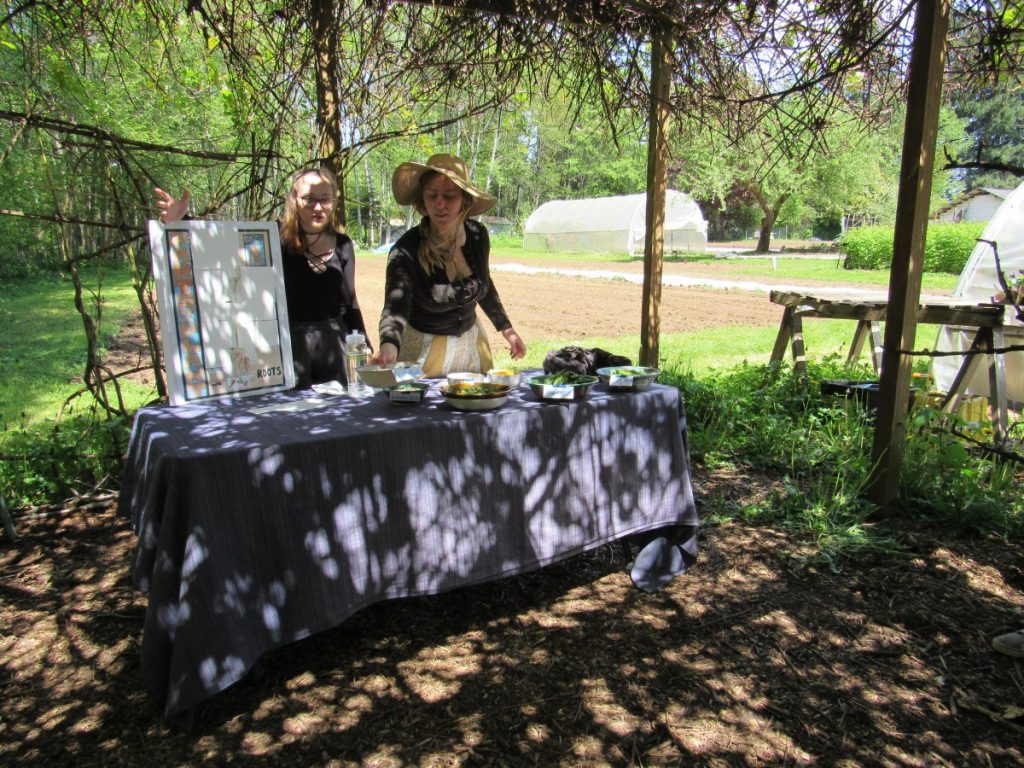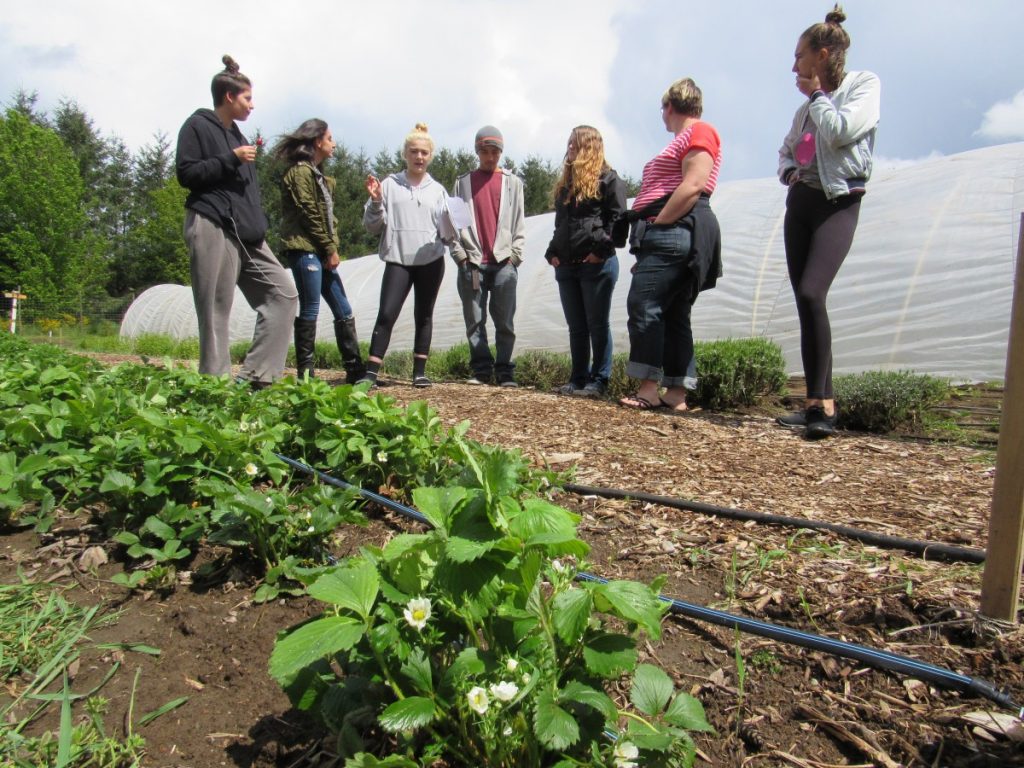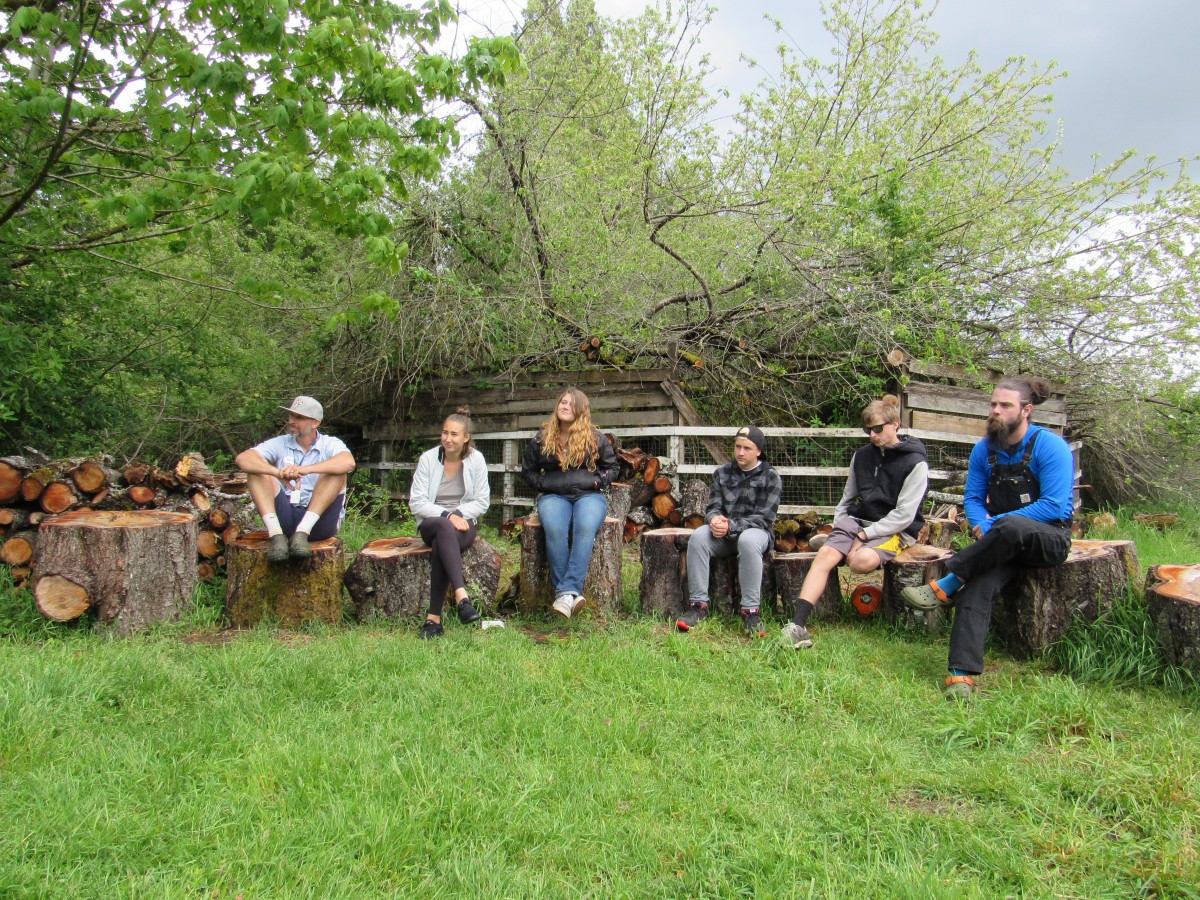The intent of The Institute is to demonstrate and discuss in detail the GRuB School Model, and so the framework it operates under is the model itself. Teaching the tools used during the school program to the attendees as if they were going through it themselves, except with more asides to offer explanations and answer questions. The agenda they presented was nontraditional, no lists or time frames; they used a visual agenda instead. A general flow of topics to be covered and when our excursion to other GRuB-like programs would be were identified, and the rest was left up to the facilitators to determine. A very freeing experience it was to not have the structure set in stone, nor be able to anticipate what’s is coming up next.
Day 1
The day began as it would with the youth, a circle up, check-in questions and game. Each of these are essential pieces of GRuB’s culture- they put everyone on even ground, allowing each voice to be heard, and face to be seen, and help us shake out the nerves and sillies with a bit of play time. The sun afforded us the opportunity to be outside, and we seized the chance. Context setting and introductions occurred and then we returned to the indoor classroom for our first lesson.
Building a Community Contract with the people present allows everyone to understand the needs and expectations of their peers and airs the basis for interactions heretofore. Setting goals prior to this exercise was emphasized, as it allows individuals to reflect on why they are there, and what they are hoping to get out of it. With that established, they can then create the foundational framework for achieving those goals. A few of the standard points that are shared are respecting differences, active listening, confidentiality , and challenge by choice (meaning choosing when and how you participate in activities). The facilitators suggested having a community contract for your organization, with the “high level” goals setting the stage for it.
GRuB’s Guidelines, adopted from Visions Inc., are another framework that the whole organization operates under. The list, to which I have referenced throughout the quarter, provides eight “principles for successful outcomes across cultural differences”. It is referred to often at GRuB, and is well engrained in the culture and dialog of the community. It teaches things like “trying on” different perspectives, and keeping an open mind, and “practicing both/and thinking” which aims to hold two different perspective with equal value. “Intent and impact” are considered there in, as well as attention to “process and content”. These and other guidelines are huge contributors to the organizations ability to bring communities together and welcome every individual to the table, to share food and ideas, in an effort to learn and grow.
For each activity and lesson plan developed for the youth program, the staff check its content for suitability to four criteria- the 4 R’s- relevance, relationships, responsibility, and rigor. To ensure that the youth and the organization are utilizing their time and efforts the fullest, programming is checked to these four principles. An undertaking that builds relationships and gives responsibility to youth, but is irrelevant to their lives and does not challenge them, does not, in GRuB’s model, best serve them. When each of the criteria is met, it provides a strong atmosphere for learning.
Part of the afternoon was spent discussing available resources and strategies for implementing GRuB-like programs into school districts or various organizational structures. Most of this discussion was not highly pertinent to me, at least at this time, but was still very informative and interesting to hear. There was also a tour of the farm, and examples of the field trip program workshops lead by the youth crew. Observing this from a participant’s perspective rather than as a facilitator was joyous and sparked unique observations that I later used in my continued curriculum development work. My greatest takeaway from the day was the 4 R’s; an excellent tool to check myself and my engagements and keep myself accountable to a standard work ethic.

Day 2
Again we began with check-in question, circle and game to reground into the space and set intentions for the day to come. Our first activity was in team building, an important tool in developing community with the youth, fostering trust and working out the kinks in communication. We played a game called “helium stick” where the objective is to lower a stick to the ground keeping just fingers of group members in contact with it at all times. The tendency is for the stick to actually rise up as you try to lower it, because keeping contact is a requirement. Frustrations arose, and communication changed. We tried several techniques to no avail, only when two people tried alone, leaving out about eight others, were we successful in achieving the goal.
We returned to the indoor classroom once more to debrief the exercise. It was noted that as facilitators of the activity, you must afford as much time or more to discussing the activity to actually learn the lessons there in. We walked through the mental process set forth by the instructor- what happened? What did you observe? Then we answered, so what? What was the significance of that? Why did we do this? What was learned? And finally, what are the applications of this? What can you do differently from here? This process is extremely important because often these “team bonding” activities can actually break down and fail. My favorite lesson here in is just that- sometimes failure and conflicts that arise are or great value as they bring up the emotions that a just below the surface and so much growth can come of the discussion and processing.
In the afternoon we looked at more tools and techniques for engaging with youth including “pros and grows”, requesting a change in behavior, having “check-in conversations”, and working through the “life cycle of a group”. We learned that it is important to be mindful of tone of voice, using “homie voice” and I statements goes a long way. Enter these engagements free of assumptions, prepared to affirm positive behaviors and characteristics for the individual, and with clear intentions to support them. An awesome phrase to utilize is, “what does … look like for you”, including in the blank something like “working hard”, or the behavior you are trying to encourage them to. It is useful to refer to the guidelines and community contract, asking them if they think they’re upholding those agreements. Ultimately, these strategies offer an alternative to the authoritarian nagging and punishment, instead empowering the individual to self-reflect and create their own solution and change.
The culminating activity for the day is called Community Build, which both institute attendees and the high school youth participated in. It is designed to shed light on the different access and treatment communities receive based on socioeconomic and racial differences. It begins with little explanation, just the goal set of creating the best community based on health and activity. We are given resources like a “debit card”, and materials to draw and build representatives of structures we purchase permits for, like a farmers market, community health center and/or parks. Each group separates to different parts of the farm house to begin designing their dream communities. Once decisions are made, we had to get permits from the “county office” and if necessary loans from the “bank”. Authority figures were also present. My group, the beet community, was packed out front, on the small porch, and had the most members. We soon learned we were also located conveniently next to the prison. One of our group members was arrested for loitering the first time we went to the offices. Once there, we were refused our request for a community garden, citing the need to provide soil tests as there was supposedly lead contamination.
We met resistance at every turn, not trusted to get loans, noise complaints and arrests for failure to comply with a number of made up excuses, and the loss of paperwork resulting in us paying a fine. We paid bail for a while, until half our community was in jail, and then the remaining members dropped the goal of trying to make the best community and instead began protesting the injustices we observed. This ended in the entire group being sent to jail for a while. We attempted to spread the word of how we were being treated, but were repeatedly stifled. The few individuals we did speak with, were either prevented from supporting and even engaging with us, citing restraining orders and public safety, or were too caught up in their own desire to “win” to pay us much attention. Emotions ran high, voices were raised, and eyes filled with tears.
Then we debriefed. This activity brought up many painful perceptions and emotions for people. Some were shocked by their own behavior and guilt when placed in the privileged community, others in the rural community (which had been isolated upstairs in a closed room) surprised by the challenges they faced in building things for the community so spread out. Most in my group (representing the urban low-income population), and a few in others were furious with the oppression we faced and as it hit home for several, brought out a lot of raw feelings. This activity, for me, elevated the significance of food justice work in my mind, highlighted how intrinsically interwoven it is with racial justice and community building and organizing. Put into context with the engagement techniques and communication styles just taught, that provide a solid container for the work and the dialog, I was emboldened and humbled by the weight of it all.
Day 3
This final and short day was focused mostly on elaborating on a few rushed topics and holding free space to allow participants to ask focused questions and to discuss different aspects of the model in mini groups. I jumped between each, very inwardly focused after the heaviness of the day prior, and picked up a few more tidbits on organizational strategies.
The other half of the day was spent touring two other pollinated high school programs at Olympia and Tumwater high schools. At Tumwater we met with the principals, who answered some of the administrative questions people had. The other site visit took the form of a tour, led by the high schoolers, called freedom farmers. They walked and talked us through their days (explaining many of the tools we had just learned and why they were significant to them), through the parts of the farm, and through the direction the program is taking as it adopts a second year model. We were also able to ask the group for their perspective and answers to some questions people had about the youth side of this model. It was an enriching experience and settled me comfortably back into the power and purpose in the agricultural education model I am learning and practicing.

We did some final processing pieces once back at GRuB, in an activity called Rock, Stick, Leaf. We are asked to say what rocked about our experiences, what lessons or feelings were going to stick, and what were we leafing behind? An awesome activity, I found, especially because it is so simple and has a natural theme! We closed with Counsel, an approach taught to the facilitators, that resembles native practices and encourages individuals to speak and listen from the heart, clearly and concisely. I have experienced this once before, and really appreciate the spontaneity of the practice and the opportunity to hear and feel peoples’ vulnerable mental processes.
* * *
Overall, the Institute provided an immersive experience and in depth look at the inner workings and impact of GRuB. It has affirmed my desire to work in a similar capacity and strengthened my confidence and capabilities to communicate with these tools. As I tie this experience into the reading and practice I’ve done with Nonviolent Communication (NVC) this quarter, I realized just how intrinsically related they are. The language of NVC informs and is produced by the integration of the aforementioned engagement tools. To hold each of them in my practice and learn them well enough that they become second nature, will only strengthen my influence and impact, broaden my perspective and understanding and launch me into new and challenging opportunities for growth.

Be First to Comment